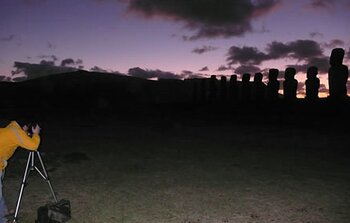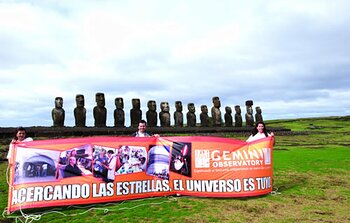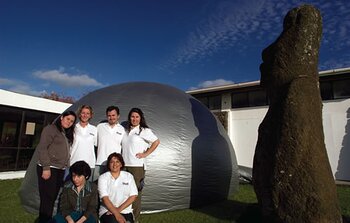Gemini Reaches Out to Easter Island (Rapa Nui)
August 28, 2009

We found ourselves in the Mataveri airport, the most isolated in the world, in the middle of the Pacific Ocean, 3,700 kilometers from continental Chile and nearly equally distant from Gemini North and Gemini South telescopes. Once again reunited with more than 200 kilograms (approximately 880 pounds) of equipment and education materials that LAN. Cargo graciously transported a few days before our arrival, we began our first astronomical cultural exchange on the island.
While our host organizations facility, the Museo Antropológico P. Sebastian Englert (P. Sebastian Englert Anthropology Museum), was being fumigated for dengue fever in the early morning hours, Gemini’s team was assembled. Our team, consisting of La Serena and Gemini Argentina National Gemini Office staff, gathered in the island’s cultural center where we met the inquisitive island students that came to visit us on the first day. That same day the students participated in a talk by Professor Carmen Gloria Jimenez from the University of Concepción. The students were allowed to hold several meteorite pieces and, judging by the look on their faces, we definitely captured their attention.
In the afternoons, the museum allowed us to use their rooms to hold the Family Astro workshops where we taught a group 30 people, as enthusiastic as they were diverse. The attendees included a judge, firemen, hotel staff, and professors, members of folklore groups, journalists and photographers who were delighted to have the opportunity to expand their knowledge. The museum constantly supported us by notifying the local press of our activities and they offered us another room where we installed the StarLab portable planetarium for the rest of the week and shared the universe with more than 700 students that were transported in groups courtesy of Turismo Aku.
Gemini’s visit coincided with several exceptional events, such as the visit of political figures associated with the presidential campaigns and the historic visit of Colo Colo, one of the most important soccer teams in Chile who played a friendly match against the local team. Without a doubt, the Rapa Nui community, made up of nearly 3,000 inhabitants, had an exciting week where astronomy captured a third of the population.
During our stay we visited the island’s Hogar de Menores (Children’s Orphanage) and the prison as well. We also received local guided tours that were great learning experiences, such as the sunrise at Ahu Tongariki where 15 Moai, averaging almost 20 meters high, began to appear in front of our eyes below the constellation of Orion which, coupled with a reddish sky, provided the perfect environment for the transition between ancestral and earthly.
We toured ancient caves and witnessed countless petroglyphs in Orongo. Additionally, we had the opportunity to participate in a discussion given by native archaeologists who educated us in the latest discoveries from this triangular island.
Our trip was made jointly with the University of Concepción, whose professor Carmen Gloria Jimenez, member of the Teachers in Space program and candidate to become the first Chilean to fly in space, supported the sessions on solar and nighttime observations and also offered talks to the interested community.
Finally, we can proudly say that since August 7th, the William Mulloy Library Museum has all the computer equipment necessary so that the Gemini Virtual Tour will be available to the community at no charge. This, along with our visit, is part of the International Year of Astronomy (IYA), during which the Gemini Observatory has reached places in Chile that we have never serviced before. To circulate astronomy at Easter Island is a perfect destination since next July their residents will have the privilege of witnessing a total solar eclipse.



